Here is my first finished painting completed as an artist in residence at Phoenix Athens in Greece! It depicts a wild sparrowhawk chick in a somewhat stylized nest of branches.
This is Potential, acrylic on papyrus, 24x16.5”, 2023.
Residencies
Here is my first finished painting completed as an artist in residence at Phoenix Athens in Greece! It depicts a wild sparrowhawk chick in a somewhat stylized nest of branches.
This is Potential, acrylic on papyrus, 24x16.5”, 2023.
Shelby Prindaville’s painting of a wild Eurasian sparrowhawk chick on papryus.
I arrived in Athens on Monday, June 12th in the late afternoon, and by the time I got my checked luggage and took a taxi to my residency, it was around 6:30pm. I greeted my hosts and their two artists in residence. The residency director, Dimitri, showed me to where I’d be staying and mentioned he didn’t have time to prepare it as he would have liked but hoped it would be acceptable and that he knew I wanted access to A/C (I had requested that if possible given that it can get up to 104°F/40°C in the summers), which this apartment has. Then we went out for drinks and invited a field biologist friend of Dimitri’s, as I had asked to have him show me some of the local fauna and flora on the nearby Lycabettus mountain. It is also the highest point in the whole city (and is inexplicably titled a hill here, as in Lycabettus Hill, but I assure you - and have photographic proof - that it is not!).
I returned back home and went to bed. I awoke in the middle of the night and discovered a large cockroach, so the next morning Dimitri brought a can of spray over. Unfortunately, it turned out to be a bigger infestation than the can of spray could resolve, so he then spent hours patching crevices and holes in the place with cement, caulk, and tape, and finally a couple days later an exterminator came. Since then, I haven’t seen another (fingers crossed)! In the midst of dealing with that, my bathroom plumbing also flooded the place with contaminated water, and we’ve since had three plumber visits - I now have a brand new toilet, too. I’m hoping that was all my bad luck for the trip, right at the beginning!
I’ve had great luck, too, though! On my second day here, I went up Lycabettus with my new field biologist friend (somewhat confusingly for narrative purposes, he’s also named Dimitris so I will just refer to him as the field biologist). He brought his very nice birding photography gear, including a tripod and scope, because he has been observing a sparrowhawk nest and was happy to show it to me. It was AMAZING. I had a great time observing them; I’ve seen both adult and baby raptors up close before at LSU Vet Med, wildlife sanctuaries, and/or zoos, but to intimately see a healthy, wild sparrowhawk family through a scope was magical. We then climbed to the top of the mountain at sunset to get a bird's eye view of the city and the Acropolis. A few days later, I went on a five-or-six mile walk around the Athens city center and the base of the Acropolis with one of the other artists. I next visited the National Garden, as I was hoping to find one of the native tortoises. I did not, so I went back up the mountain the following afternoon to try to spot some, but then heard from other people in the trails that they're mostly around in the early morning. However, the trip wasn’t wasted as I then ran into a Eurasian hoopoe. Unfortunately, I had the wrong camera settings still running from the previous evening and didn't realize it, so those photos are not usable.
Interspersed between all of the above events was studio time! I began work on two different sparrowhawk paintings on papyrus and have been trying to get the surface of the 19th century tiles I acquired in Amsterdam to become more receptive to paint, as I want to use my OPEN Acrylics atop them and would like the resultant work to be relatively archivally stable. First, I tried hand sanding to no success. Then I tried a rotary sanding attachment on an angle grinder, but the surface of the tiles is not actually flat so it left a lot of pockets of shiny glaze. I decided to see if I could find a store capable of etching my tiles instead, as etching liquid/cream or sandblasting would uniformly work on irregular surfaces. I took the tiles to a glass store that told us they could sandblast them, but when I arrived it turned out their sand was far too fine and it would not result in the type of more open surface I was looking for, so they sent me to a sandblasting factory. There, they assured me they could do it and that I should come back the next day to retrieve them and pay. However, the next day it turned out the glaze was too hard for their sandblasting material, and they could not do as I’d asked after all.
The food here has been uniformly delicious, and Athens is in my opinion the most vegan and vegetarian-friendly city I’ve been to, which has been a very pleasant surprise! I knew the Mediterranean diet would lend itself pretty well to my vegetarianism, but there are an abundance of purely vegan restaurants around and several servers have proactively offered vegan modifications to vegetarian dishes.
I’m beginning a new artist residency, but I still have some paintings I’d like to do from my summer 2022 artist residency at the Louisiana State University School of Veterinary Medicine so I worked on them before I headed out! Last summer I had begun, but not yet finished, the contour drawing underpinning this painting of two juvenile possums. I worked on the background this past fall, and began to paint it at the beginning of this summer! The background is a chemical stain from the anatomy lab; I’ve had some trouble with the lightfastness of the veterinary stains I’ve tried in the past, which is why I gave this one so much time between setting it down and painting atop it! Both due to the time involved and my research, I have more faith in this particular stain’s staying power. This stain is called orcein and is derived from lichens, and it has been used as a fabric dye in addition to scientific usages.
This is Overlooked, acrylic and orcein stain from the LSU SVM anatomy lab on Aquabord panel, 24x18x1.5”, 2023.
I am very excited to announce that I will be a Villa Exarchia artist-in-residence at Phoenix Athens with director Dimitri Yin in Athens, Greece for six weeks this summer!
I hope to create a new body of artwork atop substrates that speak directly to the age and history of Athens: papyrus, old ceramic tiles, and marble. Dimitri has shared that I will be able to visit a population of endangered tortoises residing nearby, and I look forward to documenting them as well as other fauna and/or flora in the Athenian ecosystem.
This will be my first time in Greece, and it will also be my first international artist residency since the pandemic descended (though it will be my ninth international residency and thirteenth residency total).
Είμαι πολύ ενθουσιασμένη! (That hopefully is Greek for “I am very excited!” I’ve been learning a little Greek in anticipation of my stay, but it’s pretty slow going as switching to a new alphabet is difficult for me.)
Louisiana State University’s School of Veterinary Medicine just launched a new magazine, titled UPROAR. For its inaugural Spring 2023 issue, my painting Wild Card is on the cover and a feature story on my trailblazing artist residency is inside! Here’s a digital version to check out, with some screenshots included below. Hopefully I’ll receive contributor’s copies in the mail soon!

LSU School of Veterinary Medicine’s inaugural Spring 2023 issue of UPROAR Magazine has cover artwork by Shelby Prindaville as well as a feature story on her trailblazing artist residency.

LSU School of Veterinary Medicine’s inaugural Spring 2023 issue of UPROAR Magazine includes a feature story on Shelby Prindaville’s trailblazing artist residency.
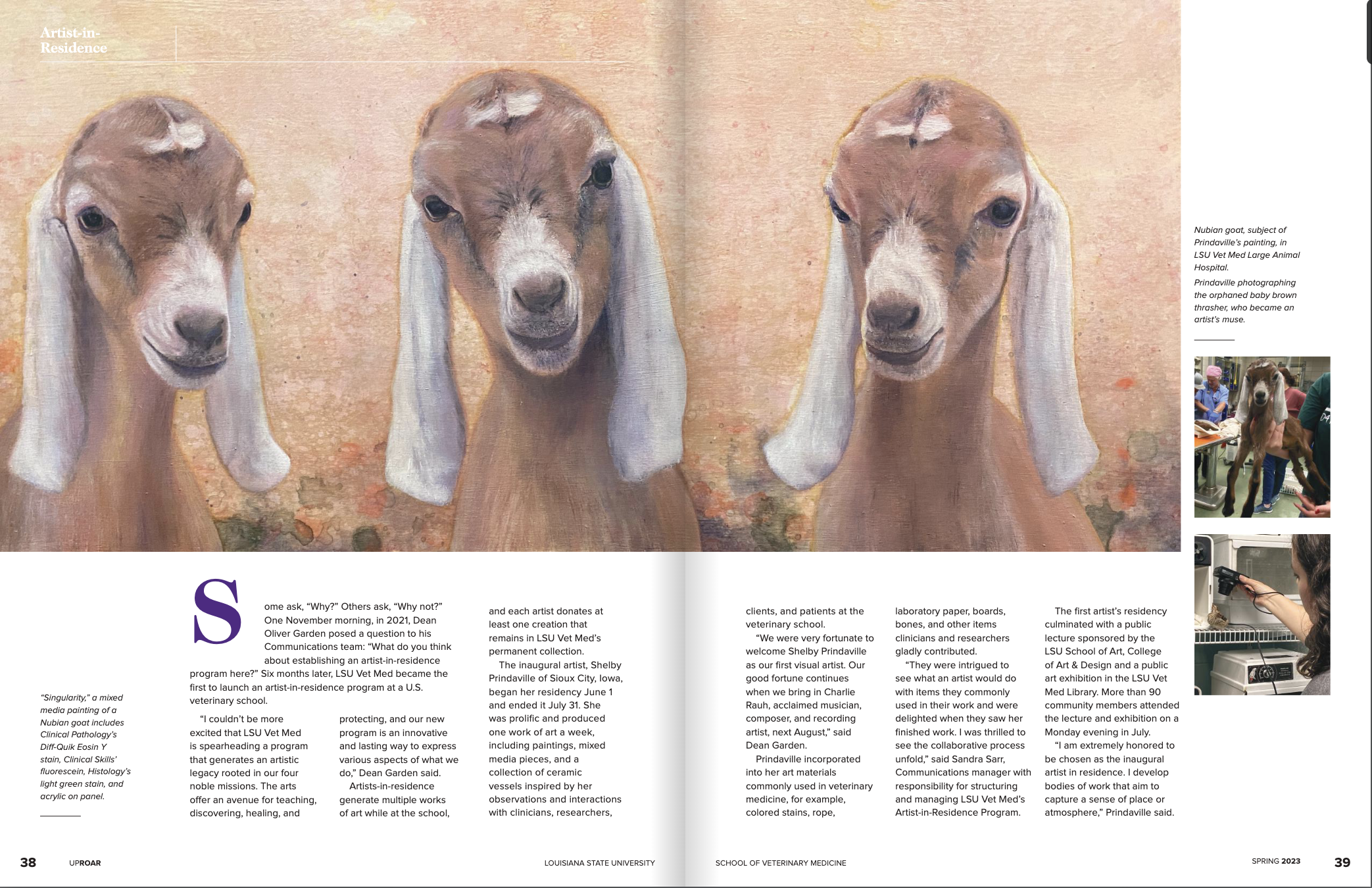
LSU School of Veterinary Medicine’s inaugural Spring 2023 issue of UPROAR Magazine includes a feature story on Shelby Prindaville’s trailblazing artist residency.

LSU School of Veterinary Medicine’s inaugural Spring 2023 issue of UPROAR Magazine includes a feature story on Shelby Prindaville’s trailblazing artist residency.

LSU School of Veterinary Medicine’s inaugural Spring 2023 issue of UPROAR Magazine includes Shelby Prindaville’s cover artwork and a feature story on her trailblazing artist residency.
An in-progress photo showing my contour drawing which underpins the finished painting!
I made the acquaintance of this inchworm at Whiterock Conservancy, and began the contour drawing over a year ago. I picked it back up this winter break!
The title of the piece, Earth Measurer, is the English translation of the Ancient-Greek-derived “geometer.” Geometridae is the scientific name for the family of caterpillars (and moths) that make use of the distinctive method of locomotion that is not only described in the family’s scientific name but also in many of their common names: inchworm, spanworm, looper, and measuring worm.
After spending a lot of time really looking at inchworm anatomy and learning terminology (FYI, they have true legs and prolegs), I am again impressed with the variety and richness of animal forms in the world; there’s plenty of alien to explore right here. This past summer, while painting mosquitoes from LSU Vet Med’s epidemiology department, I was surprised by how hairy they are upon examination. Similarly, on this so-called hairless caterpillar, there’s still a fair amount of hair, called setae! I included it in the painting as well, though you’ve got to get close to the painting or zoom in quite a bit to see it.
This is Earth Measurer, acrylic on basswood panel, 6x12x1.5”, 2023.
Here are some photos from my three-person show Whiterock Art at the Betty Strong Encounter Center in Sioux City, IA! You can still check out this exhibition in person through November 13, 2022. I have 37 works on display, including 20 chromatograms, 15 site-specific ceramics, and 2 painted bas reliefs on panel using the polymer clay I helped create (QuickCure Clay).
As you can see, I arranged dried botanicals harvested from Whiterock Conservancy in four of my 41.816, -94.646 ceramic vessels to show this ceramic collection’s utility and connection to the landscape. My friend, former colleague, and master ceramist Susan Nelson inspired me to do this, as she often shows and photographs her ceramic work with ikebana, or the art of Japanese flower arrangements. I also placed a representative sampling of the small rocks, twigs, and other debris I cleaned out of the clay in a fifth display inside one of the smallest dishes.
At the reception for the show, I sold four of the 41.816, -94.646 ceramic pieces! I was pretty pleased with that, particularly because my price point for pieces in this collection was significantly higher than that of my stoneware work, given all the additional labor that went into this site-specific series. One of the buyers selected a piece holding dried botanicals, and another picked the vessel containing the rocks, twigs, and debris cleaned out of the clay body; both shared with me that they plan to keep those displays intact. That intent surprised me, but I’m happy that my decorative touches felt so appropriate that they’ll continue on beyond the exhibition!
You may remember I attended an artist residency at Whiterock Conservancy outside of Coon Rapids, IA, in summer 2021. My good friend and colleague Terri McGaffin had already completed a residency there that spring 2021, and turned me on to the opportunity. Another Sioux City artist, Pauline Sensenig, then followed suit this summer 2022.
All of us will be exhibiting our work in a three-person show called Whiterock Art at the Betty Strong Encounter Center in the Lewis & Clark Interpretive Center in Sioux City, IA, from October 2 - November 13, 2022. The reception will be on Sunday, October 2nd at 2pm, and I hope you can join us - there will be a reception and presentation by Whiterock’s own Liz Garst, co-founder and Board of Directors member of Whiterock Conservancy.
I designed our show logo, postcard, and poster (viewable at the exhibition) - below you can take a look at the digital postcard.


The Morningside University News just got in on all the excitement - “Associate professor of art Shelby Prindaville uses skills towards historical process” was published on August 26th! The image on the right is a screenshot of the introduction, but check out the whole article in the link above or take a look at this PDF.
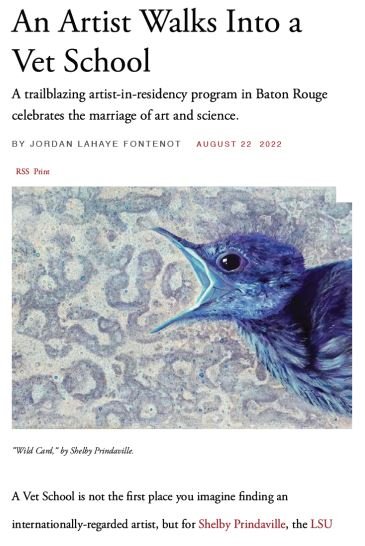
Country Roads Magazine just published a fabulous article on my LSU Vet Med artist residency in both their digital and September print edition! On the left, you can see a screenshot of the beginning of the write-up to whet your appetite.
You can read the digital piece here, see a full PDF, or pick up a physical copy if you’re in the Louisiana/Mississippi distribution zone!

I’ve been getting some nice Louisiana press for my summer LSU Vet Med artist residency, and now there’s great local coverage as well - with more in the works! Here’s the Sioux City Journal digital article “Morningside professor participates in first-ever artist residency at LSU vet school” by reporter Dolly Butz, and here’s a PDF of the print version!

Louisiana Public Broadcasting Service’s The State We’re In did a televised feature on my artist residency and exhibition at the LSU School of Veterinary Medicine - you can watch it here!
From their own website: “Louisiana: The State We’re In, Louisiana's only statewide news magazine, is in its 45th season on the air. The program airs Fridays at 7PM and Sundays at 4:30PM on the six-station LPB network that includes stations in Alexandria, Baton Rouge, Lafayette, Lake Charles, Monroe, and Shreveport. It also streams at lpb.org/livetv and airs on LPB’s sister station WLAE-TV32 in New Orleans on Fridays at 7PM and on WYES-TV, the PBS station for New Orleans and the Gulf Coast, at 7:30PM.
This award-winning show combines in-depth coverage about the important issues in the state along with expert analysis. […] It is one of the longest-running television programs in the nation.”
Here are photos from my solo exhibition and opening reception at the LSU School of Veterinary Medicine, co-sponsored by the LSU School of Art! The reception was amazing; over 80 people attended and they were all very engaged throughout the evening. We began with a welcome speech delivered by LSU School of Veterinary Medicine Dean Oliver Garden, followed by speeches from LSU College of Art + Design Dean Alkis Tsolakis and LSU School of Art Director Rod Parker, and then my artist lecture!
By the end of the evening, 6 of the 8 paintings/relief/sculpture were sold (only Hosts and Singularity remain available), and 3 of the 13 ceramics were purchased in addition to countless prints and greeting cards. Through the course of the rest of the exhibition, 3 more ceramics sold along with additional prints and greeting cards. I was a little surprised at how popular the mosquito reproductions were as they sold out quite quickly, but I’ve since learned there’s a well-known joke that mosquitoes are the state bird of Louisiana!
In the slideshow, you’ll see that in addition to the artwork walls and reproduction sales table, I also had a display table of some of the veterinary materials - medicines, chemicals, stains, tools, bones - I used in each of the pieces of artwork!
Here are a couple of photos of the in-progress Vulture Sculpture! In the first image, you can see how I built an internal armature out of pink styrofoam insulation, wire, and disposable chopsticks. Armatures are really helpful for a few reasons: A) they provide structure and support to bolster strength and keep the clay from sagging, B) they weigh a lot less than clay which makes the piece-in-progress lighter so it puts less stress on weight-bearing areas while wet/uncured C) if you leave the armature inside - like you can do with QuickCure Clay - the finished piece is lighter than if it were solid clay which is typically desirable, and finally D) the armature materials usually cost less than using an equivalent amount of clay.
Then in the second image, it’s midway along; I’m still sculpting the QCC (note the head and wings are unfinished) but it’s taking real shape and I’ve already incorporated the artificial turf, though I have yet to “mold” it with the heat gun. Finally, there’s the finished piece in a similar orientation for comparison!
This is the final piece of artwork I completed on-site at LSU Vet Med during my two-month summer 2022 residency! I think finishing 20 exhibitable pieces including mixed media paintings, a relief, ceramics, and a sculpture in 7 weeks is a remarkable feat, so I am very happy with my productivity.
I worked right up until the day of the exhibition opening on this piece, but I managed to get it “finished” in time - I put that in quotes as I still needed to briefly borrow it back from the exhibition midway through to put a protective varnish on top!
I had wanted to do a sculpture this whole time because A) I’ve always liked putting on exhibitions that have multiple disciplines and media on display to more deeply engage a broad viewership, B) I wanted to really highlight QuickCure Clay, as I’d helped create it with Dr. John Pojman at LSU a decade ago and it felt right to use it in at least a couple of pieces this summer, and C) I had been given a couple pieces of artificial turf from the wildlife hospital that I wanted to incorporate into artwork in some way, and relatively early on I had a lightbulb moment wherein I thought the astroturf had vulture neck-feather vibes! It worked very well, in that a lot of people couldn’t figure out where the artificial turf was used and at least one viewer told me she thought I thought the gravel I used as an installation aid was astroturf. Another viewer asked me if this was a taxidermied piece, which made me feel really good about the likeness!
I titled this piece Vulture Sculpture mostly because I didn’t have time to think about titling it when I had to make the show labels (I didn’t even think it was likely to get finished for it!), but I also do like the rhyme and the clear identification of the species of the bird. I sold this sculpture that same evening to the fabulous Dr. Mark Mitchell from Wildlife and ZooMed and his partner Dr. Lorrie Hale Mitchell from Integrative Medicine! They very kindly were willing to let me take it on exhibit first (as I’m doing with the rest of the sold paintings), but I made some delicate choices with this piece - the claws, the beak tip - that meant I thought it best to let them just take it after my LSU Vet Med solo show came down instead of potentially injuring the piece in shipping.
This is Vulture Sculpture, a mixed media sculpture of a black vulture including QuickCure Clay and ZooMed’s artificial turf, 13.5" x 7.5" x 20.5", 2022.
Here are a few of photos of the in-progress work for Skeletal Ceramics. The first image has some of the bones used in their respective vessels, followed by two more images of the raw ware or green ware. I didn’t take photos while glazing because I was doing it outdoors in 98*F weather so I was sweaty and covered with glaze - as well as acutely aware that I probably needed more glazing time than the shop would be open for!
This is Skeletal Ceramics, assorted handmade stoneware vessels imprinted with or formed around various canine, equine, and swine bones from the anatomy lab, 2022.
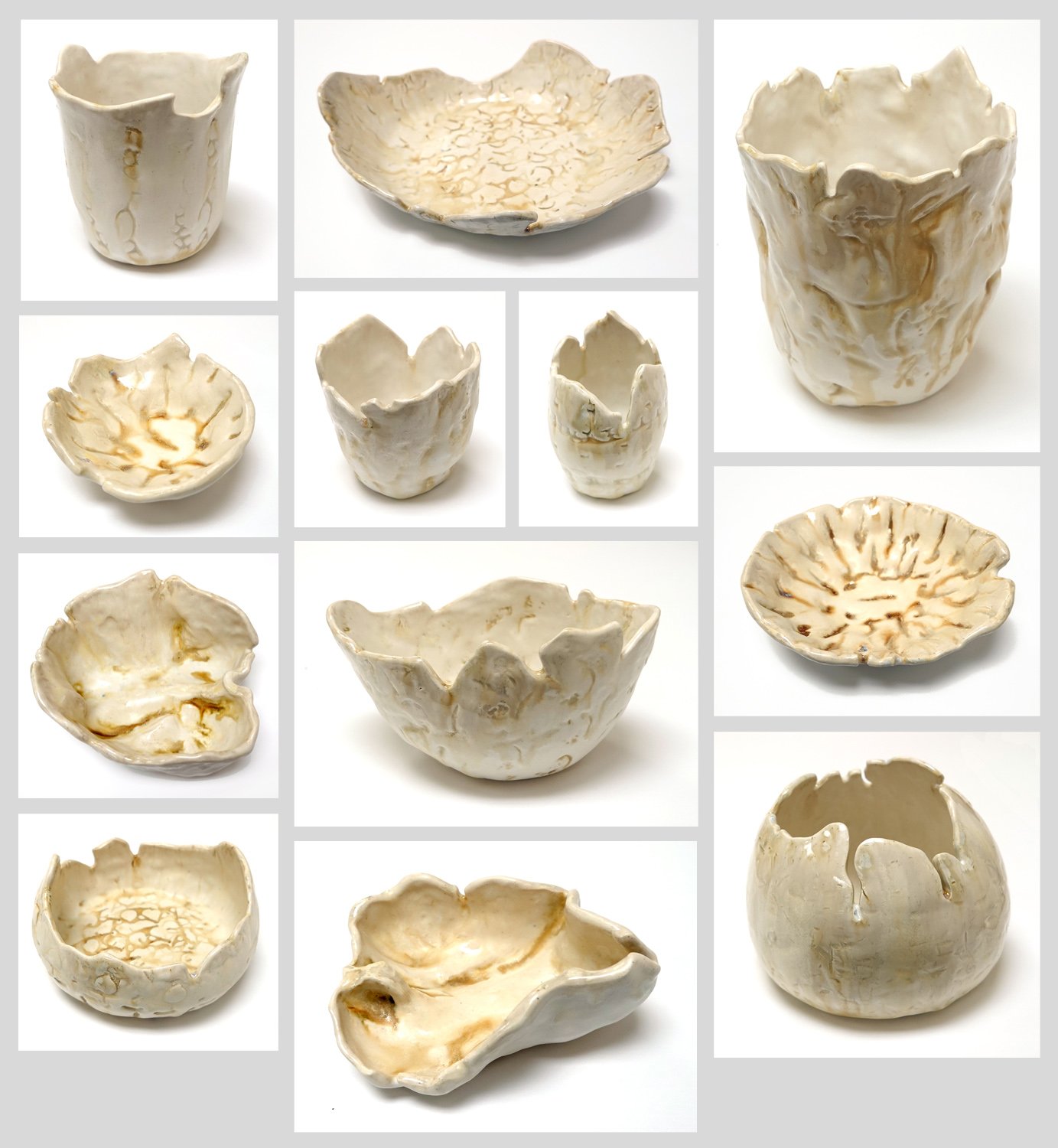
I made this body of ceramics start-to-finish on site at the LSU School of Veterinary Medicine and with purchased supplies and firing assistance from Southern Pottery Equipment. The canine, equine, and swine bones used include skulls, jawbones, various vertebrae, scapula, femurs, and sacra. The glazes used were an Amaco Shino Cacao Matte Cone 5-6 Glaze (SH-32), a Spectrum Satin White Hi-Fire Cone 5 Glaze (1121), and a Spectrum Satin Mottle Hi-Fire Cone 5 Glaze (1122). I applied the Cacao Matte to all the textured/impressed areas and then sponged off the outer surfaces, then put on a generous two coats of the Satin White, and then painted a little of the Satin Mottle on kind of haphazardly and then more carefully at the lips. I fired to Cone 6. I was really happy with how this combination performed, as they do look like bone themselves! Seven of these pieces sold during the exhibition to three different buyers.
The anatomy lab allowed me to take the bones I’ve been using back with me so that I can continue to develop this collection, so stay tuned for more.
After I was able to return to the studio from COVID, I felt a lot of self-pressure to complete all the work I had envisioned prior to getting sick and losing access for several days. I prioritized my mosquito painting, ceramics, and pig board piece first.
My very kind host Rob Carpenter had helped me order a raw poplar frame from his own framers, and he showed me how to assemble it that weekend. We ran into a bit of a snafu when the museum glass was 1/8” too long, but Michael’s was willing to trim it down (and shared that if it broke in the process they’d also be willing to recut a new piece at no additional cost since it was their error in the first place). I also have to give Michael’s, specifically one of its workers, huge credit as they mounted my mosquito netting to the matboard for me! I was willing to do it myself if need be, but the most logical process was to get the whole matboard in, apply matte medium to the whole face and press the netting on top with a large flat weight (like a piece of plywood) until dry, and then cut the matboard down to size and with the window. They agreed with me about that being the simplest way, and said that they’d take care of it since they’d be doing all the surrounding work to it anyhow! I feel like I got a little taste of what it must be like to have a professional studio assistant, and it is a very nice luxury… They also gave me free foamcore backing and put little metal tabs in as well. Once it was all assembled, Rob helped me wire it and it was finally done!
Switching gears, I was lucky that I had brought all my raw ware down to Southern Pottery Equipment to be bisque-fired just before I came down with COVID, and we decided together that given my timeline I’d go there to glaze it on site so that it could then instantly be put in the glaze firing. So on Tuesday, I headed over!
I had purchased three different glazes which in my head when combined together would give a bone-like appearance. The catch is that I was just guessing based off my previous experience with completely different glazes, and as I believe I mentioned before this was a one-shot, que será, será situation. It took me four hours to glaze all 17 ceramic vessels, but honestly I stopped because the shop was closing - I could probably have glazed for another hour more!
Much of the rest of the week was spent planning out how the show would be installed, tracking down pedestals, and finishing up the pig piece. I also recorded the Arts Council of Greater Baton Rouge podcast. Then I returned to fetch my glaze-fired ceramics! Unfortunately, none had been stilted as the shop hadn’t felt there was a need, but the satin mottle seemed to behave more as a hi-flow gloss and it ran enough to fuse a number of my pieces to the kiln shelf. A large bowl I had impressed with a pig skull fragmented into pieces, and another four pieces had pretty severe damage. One had moderate damage but was still displayable, and then another five or so had varying bottom detritus; I did the best I could to smooth them all out, but I only had a Dremel rotary tool on hand so I was much more limited than if I’d been back in the Morningside studio with our diamond grinders. Despite the damage, about half were completely unscathed and I think I ended up displaying 13 total in the show.
That weekend, I put the pedal to the metal in racing to finish a vulture sculpture I had begun weeks ago but then deprioritized. The one non-art event of the week I did sneak in was to get a haircut! I had looked at the Baton Rouge subreddit for curly hair specialists and there was a woman recommended at the local Supercuts - I decided to try her out, as the rest of the options were all $80+ and I was feeling tapped after outlaying $400 for my isolation housing on top of all the other costs of the residency.
Here are some in-progress photos of Seeing Double!
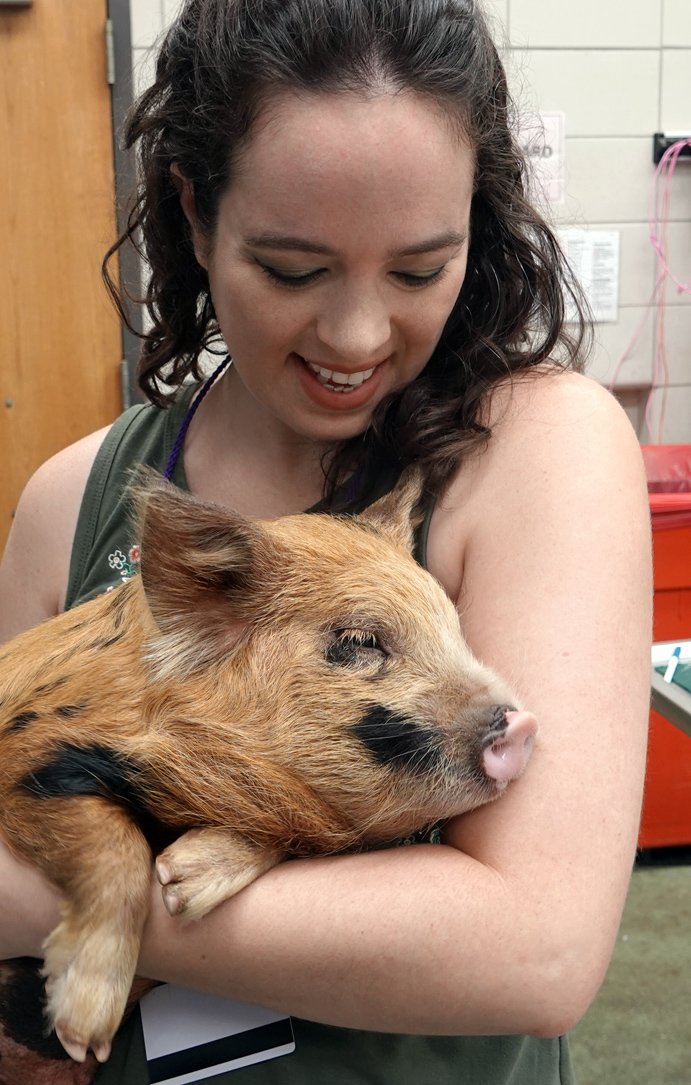
My seventh artwork almost didn’t get made on site - I knew what I wanted to do, but tried in vain to get my hands on a necessary component until Dr. Clare Scully came to the rescue!
Let me back up and explain it from the beginning. A very cute Kunekune pig named Tigger came in for observation and diagnosis and he left the next day feeling much better (and after I gave him a quick cuddle). With his owners’ permission, I decided I’d like to feature him in a painting or two! As I always do when I see a new species here at LSU Vet Med, I started asking about what veterinary materials they use specifically with that species - in this case, pigs. After hearing about a handful of items, the ones that seemed the most useful for my purposes were the pig sorting panels or “pig boards” and Dremel rotary tools (used to sand down hooves). I had brought a rotary tool with me as a sculpting aid already, so that was easy - but the pig sorting panel was a harder acquisition. This is because all the ones they had on hand were made out of plastic, and were pretty clearly intended to be easy to clean in a way that would make it harder to work archivally on top of and they were also obnoxiously colored. Wooden ones are regularly used, too, but there weren’t any in the large animal hospital as typically the wooden ones are just created on demand in a farm woodshop to save money and time.
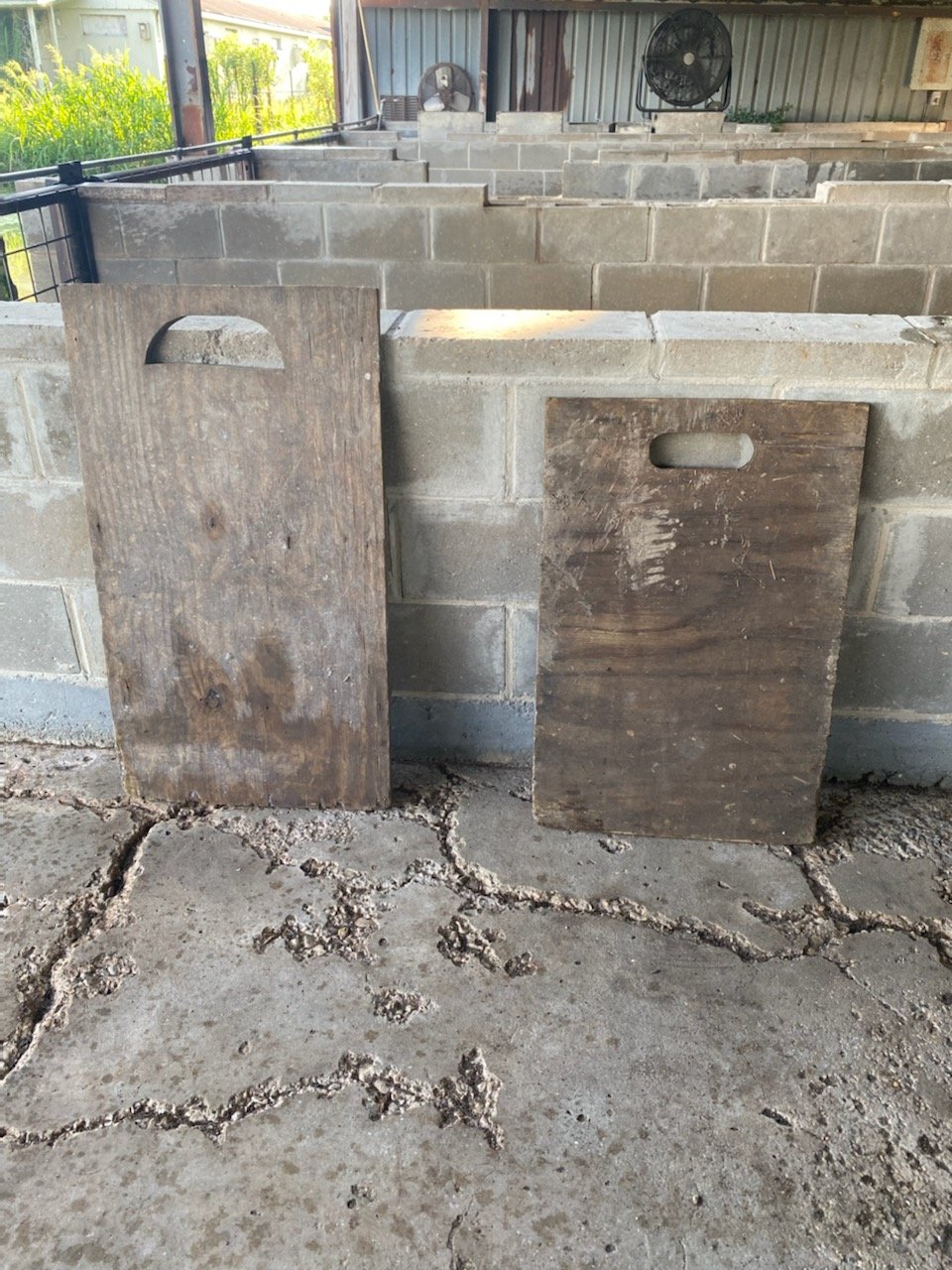
I started asking all the large animal veterinarians, residents, and students if they knew of a source, put word out via my communications liaison Sandy Sarr, and posted a Craigslist ad… but a week had passed and my show exhibition was drawing closer so I thought I’d need to wait until I could ask my agricultural colleagues back in Iowa. And then Clare came into the room, we chatted, she said she’d see what she could do, and a couple of days later, she had done it! She had found two wooden pig boards for me that were the dimensions I had been looking for from another LSU site and said they were sufficiently used as to be destined for the scrap heap, so this was a much better use for them.
I happily adopted them both and gave them a light sanding and heavy cleaning. For the first composition I had in mind, the slightly smaller and more “standard” board worked better, so that’s what I went with! I would like to photograph it again when I get back home and have access to a large white background, but this image will do for now.
This is Seeing Double, a mixed media relief including Dremel counter relief, QuickCure Clay, PVP Prep Solution (betadine), and acrylic on a used pig board / sorting panel, 29.75x19.25x1.25”, 2022.
